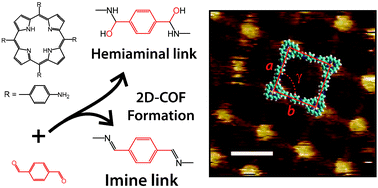Probing the chemical structure of monolayer covalent-organic frameworks grown via Schiff-base condensation reactions†
Abstract
Two-dimensional covalent-organic frameworks (2D-COFs) on surfaces offer a facile route to new 2D materials. Schiff-base condensation reactions have proven to be an effective fabrication route for such materials. We present scanning tunneling microscopy (STM) and X-ray photoelectron spectroscopy (XPS) studies of porphyrin 2D-COFs grown at a solid–vapour interface. XPS shows that covalent links between porphyrins consist of a mixture of imines and hemiaminals, a non-conjugated intermediate in the Schiff-base condensation reaction. These results demonstrate that environmental conditions during growth can have an important impact on the chemical composition of Schiff-base 2D-COFs.


 Please wait while we load your content...
Please wait while we load your content...